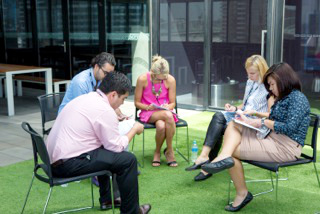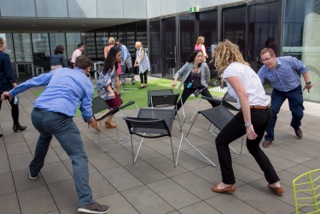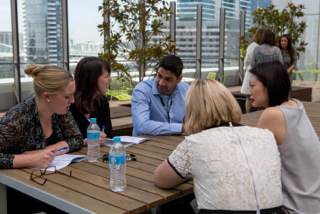Accelerating team performance
Extend your facilitation beyond the classroom
By Louise Duncan
As facilitators, we often have mere hours to help transform a team to improve performance. We apply a framework for improvement and hope the team will carry out these methods. But how can we encourage a team to make immediate change in the training room so it can be directly applied in day-to-day business?

I had an opportunity to be involved with a learning event with a group of retail leaders from all corners of the globe. In a few days, the group of 20 participants, who didn’t know each other, tackled projects including merchandising, customer service, people strategy and e-commerce. During the workshop they prepared a presentation on their findings and recommendations to present to global CEOs.
The workshop, hosted in Australia, provided a unique challenge and case study to examine how a team of newly acquainted individuals can accelerate their team dynamics. As one of the facilitators involved, I’d like to share my tips on how to speed up team development in the training room.
Put it into context
We all know the discovery process before creating a learning event is a huge factor in the overall success and outcomes. Knowing the context will present you with a plethora of insight into what drives the company and any current challenges within the team. But how do you get to the core of a company faster? Applying the elements of nature we can ask key questions that will give us direct answers.
 Earth: What’s the result? What’s the business impact?
Earth: What’s the result? What’s the business impact?
 Air: What does this mean for our job and our company?
Air: What does this mean for our job and our company?
 Water: How will this affect our team members?
Water: How will this affect our team members?
 Fire: What possibilities will be generated?
Fire: What possibilities will be generated?
In facilitation, nurturing healthy conditions to learn about your team is of key importance. Being aware of any internal conflicts or challenging areas will allow you to get the team back on track faster. Ultimately we are all striving for a balanced team that is as synergetic as nature.
Recognise individual strengths and celebrate unique differences
At the heart of every team are individual strengths that are the driving force behind a small company or a large organisation. Each individual’s role plays a key element in the overall performance of a team. Take the classic example of Ford Motor’s vertical integration. Each employee positioned on the assembly line had the same end goal – the making of a car. But in order to get to that end goal, it was crucial that each person performs to create a sell-able, well-built car. But while Ford invented an efficient model, it didn’t particularly foster an environment for communication and inter-dependent teamwork.
That’s why I compare individual strengths to nature. Nature in itself is a perfect example of synergy and interdependence. Take the four elements – earth, air, water and fire. Each element is unique but they all rely on each other to maintain a sustainable environment. We can compare these four elements to different characteristics seen within a team.
In a nutshell, Fire is bright with possibilities, Water is calm and considerate of feelings, Air is clear and logical, while Earth is firm, decisive and goal-focused. Each individual is a combination of all four elements but we all have unique preferences in the way we use our elements. Understanding those preferences and how they can balance out a team will enhance relationships and reduce conflict.
Using something simple and metaphorical like nature provides an immediate application for identifying an individual’s preferences and strengths. It’s not about labelling a person but recognising each person’s inherent abilities and their contribution to the team.
Plan to create a sense of team
 Team development doesn’t automatically happen in the training room. Facilitators need to give individuals time, skills and opportunities to build upon their teamwork. Many individuals will walk into the training room with the expectation of being told what to do. Facilitators might be familiar with Tuckman’s theory that identifies this stage as the ‘forming’ stage. In this stage, participants will wait for information until they feel they better understand what is happening.
Team development doesn’t automatically happen in the training room. Facilitators need to give individuals time, skills and opportunities to build upon their teamwork. Many individuals will walk into the training room with the expectation of being told what to do. Facilitators might be familiar with Tuckman’s theory that identifies this stage as the ‘forming’ stage. In this stage, participants will wait for information until they feel they better understand what is happening.
In a workshop, my aim is to transition the participants out of this phase quickly. By engaging participants in a task you can start to develop a better sense of awareness of individuals, team and the urgency to meet deadlines. While participants might show resistance, identifying why they are resistant to change can help alter individual focus to a broader team focus.
Flex your style as a facilitator
Having the ability to flex your style can be applied to both facilitators and team members. By flexing your style you aren’t rigidly sticking to your individual mindset but acknowledging the preferences and needs of others.
As a facilitator, your tools and models should be adaptable. What worked for one team won’t necessarily work for another. During discovery you should make sure you are engaging all four natural elements. Consider factors such as practical activities and tasks to engage participants quickly, and allow time for questions and reflection in your program design. Be prepared with backup information for those with preferences that require more analytical thought. Even factoring time for ‘fun’ will allow you to be flexible with a group that needs to engage their fire by igniting excitement in the classroom.
As a team member, flexing your style is crucially important to strengthening relationships. Using nature as a metaphor, a person who could be identified as Air will be clear and analytical when contributing ideas. A Water-preference would make the contributions more personal, by incorporating feelings. Neither is right nor wrong. Instead, they both offer a unique perspective. Rather than assuming the other team member is wrong or contributing ineffectively, we need to identify these perspectives and flex our style to accommodate them. Think of it this way: the air personality will most likely keep the team on budget while water will keep the team unified.
Real-life work application
 Keep in mind that the reason for new learning is application. In the case of the Australian workshop, the participants were able to apply their new sense of team development immediately. After taking part in the workshop, the participants were placed into teams to work on collaborative projects for the rest of the week.
Keep in mind that the reason for new learning is application. In the case of the Australian workshop, the participants were able to apply their new sense of team development immediately. After taking part in the workshop, the participants were placed into teams to work on collaborative projects for the rest of the week.
By this point you will have provided a team with a new understanding of each other and their team. You have also provided a framework to guide them but not limit their creativity. For the participants, it accelerated their performance to produce successful results to bring back to their home companies. For other teams, it’s the hope they are inspired to focus on working together to achieve the greatest results in future.
This article originally appeared in the April Edition of AITD’s Training & Development Magazine (Vol. 41 No. 2).